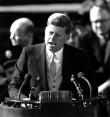Countless articles, books and documentaries have been produced about the Kennedy assassination, most peddling the conspiracy line. Although many of their authors are sincere, some are not, and forgeries and distortions abound.

What is often forgotten nowadays is that Oswald was not arrested for shooting the President, but for killing a police officer who saw him acting suspiciously. Oswald may have been trying to flee to Cuba to claim political asylum; he was heavily immersed in extremist politics, though he had no meaningful contact with organised leftist groups, and was not only a loner but largely ignored. After shooting Officer Tippitt dead in cold blood, Oswald fled to a theatre where he drew his gun on the posse that tracked him down. After his arrest, it was quickly established that Oswald, who was a crack shot, had built a sniper’s nest in the Book Depository where he worked, that he owned the murder weapon, that his prints were all over it, and that earlier that year he had tried to kill another political figure, General Edwin Walker.
Controversy and speculation were fuelled by Oswald’s curious history, and by his own subsequent murder by Jack Ruby. Certain that they had their man, the legal authorities paraded the captured Oswald before the press – something that would never happen in Britain due to our contempt of court laws. Ruby, a local nightclub owner who worshipped the President, seized the opportunity to exact revenge. Posing as a member of the press, he shot Oswald in the stomach at point blank range.
It would later be claimed that Ruby was a hit man whose job was to silence Oswald. The truth is that although a small time hustler with a propensity to violence, Jack Ruby had no connections with “The Mob”. He had expected to be hailed as a hero for administering summary justice instead of being arrested and charged with murder. He died in prison in 1967, by which time he was clearly psychotic.
Although he considered himself to be a Marxist, Oswald didn’t really understand politics. After following his older brother into the marines, from which he was (initially) honourably discharged, he “defected” to the Soviet Union when barely twenty years old. Had he been a general, the Russians would have welcomed him with open arms, but they weren’t interested in a mixed up kid. It was only after he faked a suicide attempt in his Moscow hotel room that he was granted permission to stay in order to avoid an international incident. He was packed off to work in a radio factory in Minsk where he married a Russian girl, Marina, and had a daughter.
After his hero’s welcome failed to materialise, Oswald quickly tired of the Soviet Union, and applied to return to the US with his family. The Soviets couldn’t get rid of him fast enough, and on his return he eked out an existence doing menial jobs, treating his poor wife abysmally, and fulminating his contempt for a world which failed to recognise his genius. This rage exploded suddenly and with fatal results when purely by chance this insignificant little man stumbled across the path of the most powerful man in the world, and changed the course of history.
Because of the sensational nature of the assassination and its aftermath, the government set up a high-powered inquiry under Chief Justice Earl Warren. The Warren Commission reported in September 1964. Although it misunderstood Oswald’s motives, the Commission did a thorough job in piecing together the true facts of the case, but such has been the intensity of conspiracy propaganda that even Oswald’s wife Marina succumbed to it. After initially accepting his guilt she came to believe that the man she had married was really a Soviet double. In 1981, Oswald’s body was exhumed, and forensic tests confirmed the inevitable. The ludicrous suggestion that Oswald had been substituted was fuelled by discrepancies in his reported height, something which is not unusual in medical and legal documents. Other nonsense resulted from people who didn’t understand ballistics or acoustics (the magic bullet theory and the marksmen on the grassy knoll).
That aside, it is still possible to find the truth about the Kennedy assassination. If one knows where to look! Two of the best books written about the day the world changed are Questions Of Conspiracy by Mel Ayton, and Gerald Posner’s definitive Case Closed.
John McAdam’s website which can be found at http://mcadams.posc.mu.edu/home.htm is a superb creation which debunks the countless myths and distortions surrounding the case with massive and impressive documentation.
May 2004
